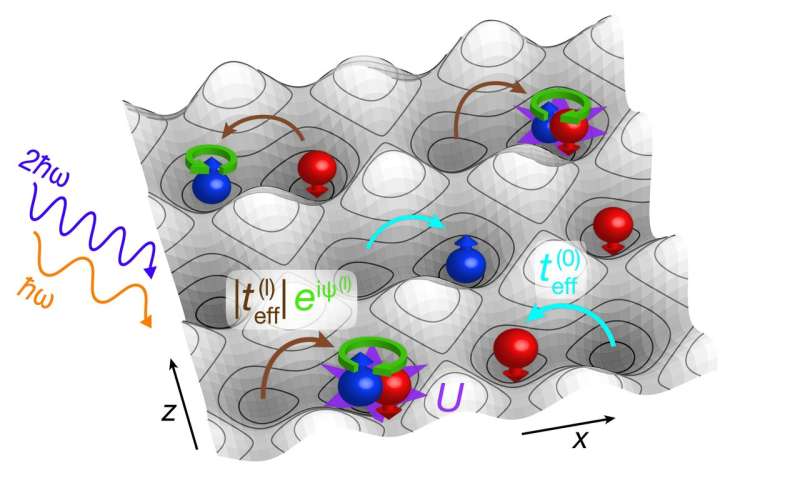September 2, 2019 feature
A method to simulate strongly correlated phases of quantum gauge theories

Quantum gauge theories are mathematical constructs that are typically used by physicists to describe subatomic particles, their associated wave fields and the interactions between them. The dynamics outlined by these theories are difficult to compute, yet effectively emulating them in the lab could lead to valuable new insight and discoveries.
In a recent study, a team of researchers at ETH Zurich's Institute for Quantum Electronics successfully implemented a fundamental ingredient for the simulation of quantum gauge theories in a laboratory experiment. Their hope is that by simulating quantum systems in a highly controlled environment, they will gather interesting observations and broaden their understanding of many-body systems (i.e., systems with many particles that interact with each other).
"Usually, our work is inspired by phenomena in solid state physics such as strongly correlated phases of electrons in complex materials," Tilman Esslinger, one of the researchers who carried out the study, told Phys.org. "In our current work, however, we wanted to extend the scope of our experimental platform (i.e., ultracold atoms in optical lattices) in order to investigate a new set of phenomena occurring in high-energy and condensed matter physics. The objective was to demonstrate that it is possible to engineer gauge fields in our setup that are dynamical quantum degrees of freedom due to their coupling to a matter field."
Gauge fields are a vital component of several quantum field theories, including quantum electrodynamics and chromodynamics. They describe a large class of phenomena in various areas of physics, such as elementary particle physics, condensed matter physics and quantum information theory. Implementing gauge fields in cold atom setups would hence allow researchers to investigate some of these phenomena in the lab.
The approach used by Esslinger and his colleagues in their study is based on a technique called Floquet engineering. This method is used to modulate a quantum system periodically over time, enabling the implementation of new physical models during the experiment that are not accessible in static systems.
In their experiments, the researchers cooled down fermionic potassium atoms to temperatures close to absolute zero. In this regime, quantum effects dominate the particles' behavior. This allowed them to study these effects in a highly controllable environment. Subsequently, Esslinger and his colleagues loaded the cooled atoms into an artificial crystal made up of laser light, thereby simulating specific behaviors, for instance, those of electrons in a solid state material.
"In order to engineer the density-dependent Peierls phases, we used a Floquet approach and shook the optical lattice along one direction," Frederik Görg, another researcher involved in the study, told Phys.org. "This allowed us to control the quantum mechanical tunneling process of the atoms between neighboring sites of the lattice."
By driving the system at two distinct frequencies with a relative phase, Esslinger and his colleagues were able to achieve a complex-valued tunneling that included a Peierls phase. As a result, the atoms used in their experiment started behaving as if they were exposed to a synthetic gauge field.
"Since the shaking frequencies are chosen to be resonant with the interaction between the particles, the Peierls phase and therefore the associated gauge field depend on the atomic configuration in the lattice," Görg explained. "This leads to a back-action mechanism between the matter and the gauge field: Atoms will start to move due to the presence of the gauge field, which in turn will change the gauge field itself."
In their study, the researchers developed a measurement scheme on an individual link of the lattice. Using this scheme, they measured the Peierls phase that the atoms pick up when tunneling on top of a second atom and compared it to the phase that they pick up when hopping on an empty site.
The researchers observed that there was a significant difference between these two phases. This suggests that the gauge field associated with these Peierls phases depends on the occupation of the lattice sites—in other words, it is density-dependent.
"Such a strongly correlated system consisting of atoms coupled to a dynamical gauge field is very hard to tackle with numerical simulations on classical computers," Görg said. "Our work is the first step toward an experimental quantum simulation of lattice gauge theories, which can shed new light on poorly understood phenomena in condensed matter and high-energy physics."
The recent study carried out by this team of researchers introduces a new versatile method to implement and simulate different classes of density-dependent gauge fields. Ultimately, the technique they proposed could pave the way for exciting new physics observations and theories. In their future work, the researchers plan to use it to study the interplay between dynamical gauge fields and atoms in many-body systems implemented in an extended optical lattice.
"We have already shown in previous work that we have a very good control over driven many-body systems and that we can mitigate problems associated with interacting Floquet systems such as heating," Esslinger said. "Together with the density-dependent Peierls phases demonstrated in this paper, our experiment provides a versatile platform to simulate and understand strongly correlated phases of quantum gauge theories."
More information:
Realization of density-dependent Peierls phases to engineer quantized gauge fields coupled to ultracold matter. DOI: 10.1038/s41567-019-0615-4.
www.nature.com/articles/s41567-019-0615-4
© 2019 Science X Network




















